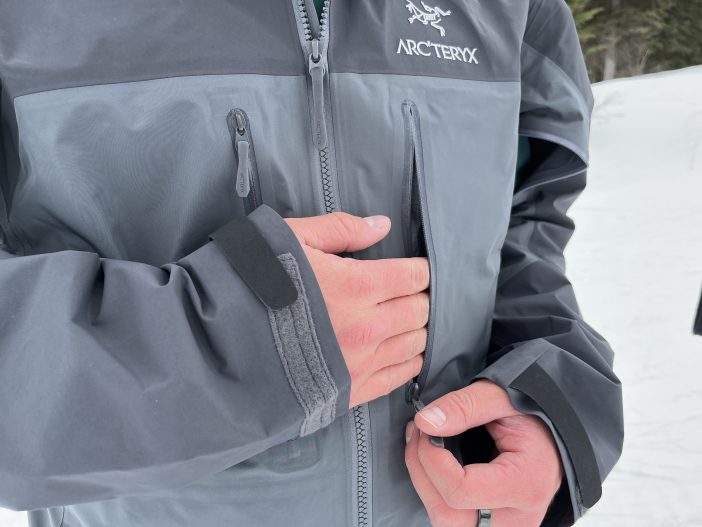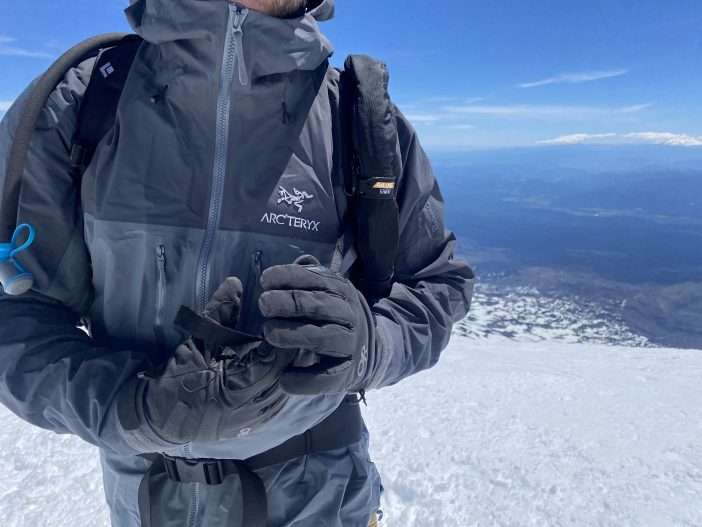The Arc'teryx Alpha line carries serious heft in the outdoor world. It is touted as the most serious, well-designed and well-built shell protection on offer. It ranges from the Alpha SV (reviewed here) to the Alpha SL, with the Alpha AR (or all-around) sitting squarely in the middle. We reviewed it across the spring and summer here in the Northwest, on the skin track as well as on glaciers.
Arc'teryx Alpha AR Gore-Tex Jacket Features:
- N40d Most Rugged 3L GORE-TEX PRO base fabric
- Strategically placed narrow GORE seam tape (8mm width)
- N80d Most Rugged 3L GORE-TEX PRO reinforcements increase durability
- Laminated high-strength hanger loop
- Micro-seam allowance (1.6 mm) reduces bulk and weight
- Cohaesive
 hem adjusters function as Hemlock
hem adjusters function as Hemlock with slight drop hem
with slight drop hem - Cohaesive
 hood adjustments for ease of use with mittens or gloves
hood adjustments for ease of use with mittens or gloves - Laminated brim
- Helmet compatible StormHood
 provides full coverage without impacting visibility
provides full coverage without impacting visibility - RECCO® reflector hidden in hood brim
- WaterTight
 external zipper, Pit zippers for easy venting
external zipper, Pit zippers for easy venting - Full front zip with wind flap
- MSRP: $600

The Alpha AR thrives on Cascade volcanoes
Alpha AR gives 100% Protection for 99% of people
It might be easiest to start this review with some comparison. The grandaddy of the Arc'teryx line is the Alpha SV jacket, which is their flagship product and is still made by hand in their Vancouver factory. We reviewed it in 2017 and the design has continued to evolve with small tweaks and an eye towards sustainability. The Alpha SV is built to extreme standards and their description of it as a 'veritable storm fortress' is pretty accurate. It's just built to the highest standards, with extremely resilient 100D Most Rugged 3L GORE-TEX PRO fabric throughout. There are other differences in the tailoring and patterning of the design, with more articulation overall in the SV. More obvious differences include a slightly different pocket configuration and a lack of an internal wind flap.
The key point here is that the SV is designed with professionals in mind. If you work in SAR in British Columbia in the winter, the SV is for you. If you are a Cascades guide, the SV is for you. If you just happen to get outside 300 days in the year because of your parents' trust fund, the SV is for you. The Alpha AR is for almost everyone else: it retains many of the premiere design elements of the flagship model as well as extremely durable, strategically placed N80d Most Rugged 3L GORE-TEX PRO reinforcements. If the Alpha SV didn't exist, the Alpha AR might just be the best shell in the world and no one would think twice.

Little details on the pockets and cuffs help set the Alpha apart
That's enough for comparison: let's talk details. As mentioned above, the foundation of the Alpha AR is the a bluesign-approved N40d Most Rugged 3L GORE-TEX PRO, reinforced with N80d Most Rugged 3L GORE-TEX PRO. The big difference there is the denier, with 40 as the base and 80 in high-wear areas like the shoulders, sleeves and hood. The functional result of this combination is a jacket that saves weight and breathes easier through the 40D base, but shrugs off moisture and friction on the 80D reinforcements.
To their credit, Arc'teryx is using a water and chemical-sparing approach called Dope Dyeing. This dyeing process cuts the steps, and produces fabrics where the threads themselves are pigmented, saving water and promising a more durable and equally vibrant shades.

The single zippered internal pocket just barely accommodates this iPhone 13 in a rubbery case
The fit and tailoring of the Alpha AR are generous, with the layering needs of outdoor athletes kept in mind. I'm 5'11" 205lbs and the size Large that I tested feels about right for a mountain-oriented jacket that's meant to accommodate puffies underneath. If you plan to use this in the city and want tighter aesthetics, you need to size down. But if you're going to do anything from resort skiing to ice climbing in this, where layering is required, it's true-to-size.
A number of features stand out on the jacket. One sign of quality is the Velcro cuff closures, which are a durable rubbery material that are easy to adjust with a single, gloved hand. I also love the StormHood, which is arguably the best in the industry in terms of offering full protection while maintaining visibility. In conjunction with a reinforced brim, the dual front and rear hood adjustments secure the hood over your head or a helmet to offer full protection while preserving peripheral vision. It's a really good hood. They also have their signature tall collar, which most brands have adopted by now, which delivers a fortress-like feeling when zipped up.

The full-coverage fortress with a nice, tall collar
Other features do what is expected of them. The pit zips, for instance, are an easy way of dumping heat and I'm glad they're there, but even Arc'teryx hasn't quite figured out how to make these pull smoothly every time. They chose a waterproof zipper for the pit zips, which is good for protection but does put up more resistance than a non-sealed zipper. It's especially difficult with a pack on. Climbing in the jacket feels fine, thanks in large part to the drop hem and shock-cord hem adjustments. No complaints there.
On the front of the jacket, the full-length sealed zipper and wind flap offer tons of protection. You'll be grateful for the wind flap on days when the gusts cut through other zipper closures. On the flip size, I found that the AR's main zip snags more often than the SV, likely due to the AR's wind flap.

Gore-Tex Pro is behind quite a bit of the Alpha AR's magic
I did miss the internal dump pocket that's featured on the SV, but not the AR. It's nice when you're alpine climbing or touring and need to dump things like your gloves for awhile. The internal pocket on the AR is pretty small, which limits its utility.
People always ask about breathability in jackets like this, and it's important to manage expectations. So much of how a jacket performs depends on what type of microclimate the wearer generates. I run hot, and I sweat: if you're an outdoor athlete, you likely know where you are at on this spectrum already. Despite the advertising claims, I would say the AR offers just moderate breathability. This fabric does not breathe as well as an activity-oriented product like Gore-Tex Active or even eVent. However, both of those fabrics tend to wear out faster and, I would say, lose their waterproofing integrity faster. The 40/80D Gore-Tex Pro combo offers best-in-class waterproofing: if you get wet, it will be because of your sweat or not maintaining the DWR.

All of the features are easy to use with gloves, even if I'm demonstrating without them here
The Good:
- Finely balanced combination of weight savings with all-mountain protection
- Really excellent design, tailoring and construction
- Versatile and adapts well to touring, glacier walking and alpine climbing. Or dog walks.
- All the key features, like zippers, hem and cuff adjustments, work great
- StormHood continues to offer best-in-class protection and visibility
- Not mentioned in the review, but RECCO is a nice touch for skiing in- and out-of-bounds
- Inclusion of bluesign fabrics and Dope Dye fabrics is a major environmental win
The Bad:
- I'd love an interior dump pocket
- Zippered internal pocket struggle to accommodate an iPhone 13 in a slim case
- Even Arc'teryx hasn't solved hard-to-pull pit zips
The Bottom Line: Arc'teryx Alpha AR Jacket
The Alpha AR offers all of the protection that most outdoor users will ever need. The thoughtful mixture of Gore-Tex Pro fabrics at 40D and 80D weights mean that the jacket can breathe, move and shed ounces without sacrificing protection. Arc'teryx conceived of and implemented all of the features really well, and they mostly work seamlessly when you're out climbing or being active. For 90% of my adventures, this is the shell that I reach for first. It's a no-brainer.
Buy now: Available from REI.com
 hem adjusters function as Hemlock
hem adjusters function as Hemlock






No comments:
Post a Comment